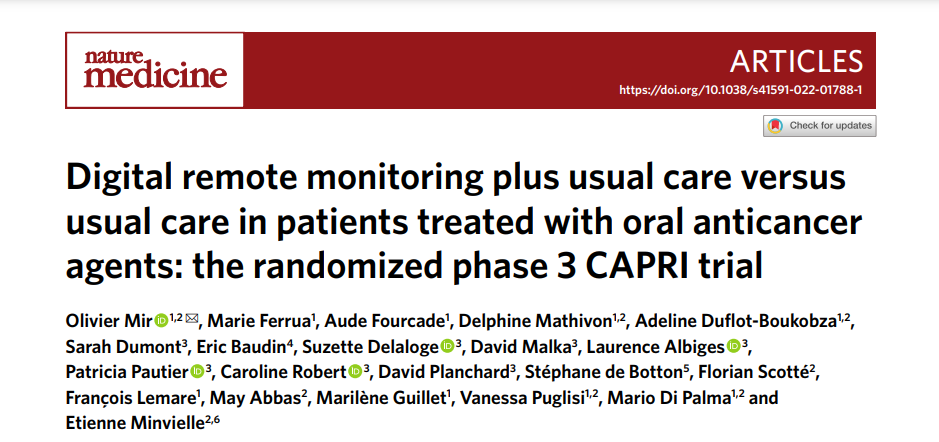A phase 3 trial highlights the importance of problem-led design, multidisciplinary commitment and patient-reported outcomes — with skilled oncology nurses having a crucial role.
Nature Medicine
Mary Wells
06 June 2022
Over the past 20 years, advances in digital health have transformed healthcare practice.
The exponential growth in this field, and in the terminology that surrounds it, has led the World Health Organization to produce a classification of digital health interventions and a global strategy on digital health 2020–2025; …
… this strategy emphasises the importance of developing and integrating appropriate, sustainable, and scalable digital interventions into healthcare systems.
Moreover, a recent analysis suggested that in 2021, telehealth use across all health specialties was 38 times higher than pre-pandemic levels.
Although digital interventions are not new to the oncology field, the COVID-19 pandemic has accelerated the wide adoption of technological solutions for remote monitoring.
This has created an urgent need for high-quality evidence to support the implementation of remote monitoring for patients with cancer.
In this issue of Nature Medicine, Mir et al. report the findings of the first randomized controlled trial of a digital remote monitoring intervention (CAPRI) for patients receiving oral anti-cancer therapy.
The use of oral anti-cancer agents has increased dramatically in recent years, therefore the study conducted by Mir et al. is extremely relevant.
In this study, patients receiving oral anti-cancer therapy were randomized to receive additional follow-up with a nurse navigator and a web portal or smartphone-based application as well as usual care, or to receive only usual care.
Although there was no significant difference in objective response or survival, the trial provides convincing evidence that remote monitoring supports higher relative dose-intensity, as well as significantly fewer hospital admissions and emergency department visits, reduced length of hospital stays, and a lower rate of grade 3 toxicity.
Moreover, remote monitoring was associated with improved overall patient experience and increased levels of supportive care (as measured by visits to dietitians or social workers).
These results are particularly relevant given that over 80% of patients in the trial had metastatic disease.
For this population, an intervention that reduces hospitalization and improves outcomes of importance to quality of life is highly valuable.
A recent review identified 11 published randomized controlled trials of remote monitoring and electronic patient-reported outcomes in oncology, and a further 9 ongoing trials, some of which have since reported positive results (for example, Maguire et al.).
The review found evidence of substantial benefits associated with remote monitoring, including reduced symptom severity, improved quality of life and improved survival.
Most trials so far have enrolled patients receiving systemic chemotherapy, but there is also some evidence for benefits associated with remote monitoring after surgery or radiation therapy.
These benefits must, however, be considered alongside the potential for exacerbating health inequalities through the ‘digital divide’.
Although relatively few patients over the age of 80 engaged in the current trial, Mir et al. achieved an impressive 92% recruitment rate across multiple tumour types, with 52% of patients using the smartphone application and 48% the web portal.
The acceptability and reach of a digital intervention to a population with varying levels of digital literacy is a vital consideration for any trial of this type.
It is no coincidence that the results described by Mir et al. were achieved in the context of a nurse navigator-led system of care, whereby the nurse navigators provided the crucial link between the patient, the hospital and primary care professionals, and the web portal.
There is increasing evidence of the role and effectiveness of nurse-led interventions in cancer care and this trial provides further reassurance that skilled nurses can manage the vast majority of clinical interventions without referral to an oncologist.
It also confirms that digital interventions do not stand alone.
Patients with cancer often feel isolated and overwhelmed, while at the same time experiencing unfamiliar and unpleasant symptoms related to their disease and its treatment.
The support of an expert oncology nurse and skilled navigator is not only vital to the usability and safety of the technology but is also key to improving the experience of the patient using that technology.
As the authors point out, the detailed design and development phase for this study was critical to its success in a real-life context.
Their excellent companion paper describes the process of developing over 80 decision support tools to support nurse navigators to prioritize and define the actions to be taken, based on alert parameters from remote monitoring.
It also illustrates the close collaboration required between clinicians, managers and patients to identify and address barriers to successful implementation.
Given the likely continual growth in oral targeted therapies and the significant unmet needs of patients with advanced and metastatic disease — particularly in terms of information and psychological support — solutions such as the CAPRI intervention need to be rolled out and embedded into routine care.
However, this is not likely to be a straightforward undertaking, as it requires a coordinated digital approach across the healthcare system of each country, and a regulatory and legal framework that is supportive of such an endeavour.
As the authors of this trial point out, regulatory and system constraints can prevent the optimization of digital health solutions across care settings and ultimately preclude their scalability.
One of the guiding principles of the WHO digital strategy is to “recognize that successful digital health initiatives require an integrated strategy” to avoid “information fragmentation and, consequently, poor delivery of services”.
In oncology, we should harness the expertise that has been developed by clinicians and researchers in this field.
The pragmatic and well-conducted trial reported by Mir et al. illustrates the importance of multidisciplinary commitment to digital innovations in cancer care, …
… and confirms that a combination of patient-reported outcomes, specialist nursing support and carefully designed technology brings considerable benefits to the experience of patients who are receiving oral anti-cancer agents.
Their insights into the complex challenges of implementing and evaluating supportive remote monitoring interventions offer valuable learnings that are crucial if we are to embrace the true potential of health technologies for patient care.
Originally published at https://www.nature.com on June 6, 2022.
About the author
Mary Wells
Department of Surgery and Cancer,
Imperial College London and Nursing Directorate,
Imperial College Healthcare NHS Trust, London, UK
ORIGINAL PUBLICATION

Digital remote monitoring plus usual care versus usual care in patients treated with oral anticancer agents: the randomized phase 3 CAPRI trial
Published: 25 April 2022
Olivier Mir, Marie Ferrua, Aude Fourcade, Delphine Mathivon, Adeline Duflot-Boukobza, Sarah Dumont, Eric Baudin, Suzette Delaloge, David Malka, Laurence Albiges, Patricia Pautier, Caroline Robert, David Planchard, Stéphane de Botton, Florian Scotté, François Lemare, May Abbas, Marilène Guillet, Vanessa Puglisi, Mario Di Palma & Etienne Minvielle
Abstract
- Strategies that individualize the care of cancer patients receiving oral anticancer agents offer opportunities to improve treatment adherence and patient care.
- However, the impact of digital remote monitoring systems in this setting has not been evaluated.
- Here, we report the results of a phase 3 trial (CAPRI, NCT02828462) to assess the impact of a nurse navigator-led program on treatment delivery for patients with metastatic cancer.
- Patients receiving approved oral anticancer agents were randomized (1:1) to an intervention combining a nurse navigator-led follow-up system and a web portal–smartphone application on top of usual care, or to usual symptom monitoring at the discretion of the treating oncologist, for a duration of 6 months.
- The primary objective included optimization of the treatment dose.
- Secondary objectives were grade ≥3 toxicities, patient experience, rates and duration of hospitalization, response and survival, and quality of life.
- In 559 evaluable patients the relative dose intensity was higher in the experimental arm (93.4% versus 89.4%, P = 0.04).
The intervention
- improved the patient experience (Patient Assessment of Chronic Illness Care score, 2.94 versus 2.67, P = 0.01),
- reduced the days of hospitalization (2.82 versus 4.44 days, P = 0.02), and
- decreased treatment-related grade ≥3 toxicities (27.6% versus 36.9%, P = 0.02).
These findings show that patient-centered care through remote monitoring of symptoms and treatment may improve patient outcomes and experience.
Originally published at https://www.nature.com













